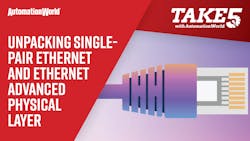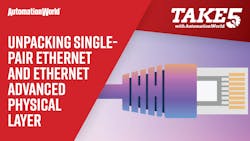Unpacking Single-Pair Ethernet and Ethernet Advanced Physical Layer

Quick hits:
- SPE has a maximum cable length of 1,000 meters.
- SPE can achieve data transmission rates of up to 10 Mbit/s.
- APL is an intrinsically safe variant of SPE.
- Industrial Ethernet Advances Broaden the Network’s Value Across Industries
- The Benefits of Ethernet-APL
- BASF Applies Ethernet-APL
- Visit PMMI's Business Intelligence Library and download their executive summaries of their latest reports for free
Hello and Welcome to Take Five with Automation World. I’m David Miller, Senior Technical Writer for Automation World. Today, I’m going to be talking about Single Pair Ethernet, which we will henceforth refer to as SPE, and Ethernet Advanced Physical Layer, which I’ll refer to as APL for short.
And the reason I’m talking about these technologies is because they really are fairly new, and so while many have heard of them, they may not know what they’re all about.
So the first question here that obviously needs to be answered is what are SPE and APL. We’ll start with SPE – SPE is simply a form of Ethernet that uses a single twisted-pair of wires, whereas other forms of ethernet use two, or three twisted pairs. Because of this, it has a smaller footprint, and the cabling can be run up to 1,000 meters without signal decay, making it ideal for expansive process industries environments such as an oil field or a large wastewater treatment facility.
On top of this, it has some other very particular specifications that make it useful. While it’s slower than other forms of ethernet, it’s still a lot faster than fieldbus. So what we’re looking at here is a goldilocks situation – with fieldbus, the porridge was too cold, meaning the bandwidth was too low – with typical industrial ethernet prior to SPE, the porridge was too hot – meaning that it was overengineered – there was more bandwidth than was needed, and it came with other drawbacks, such as more limitations on cable length due to the need to maintain that signal. SPE is just right – It gives those in the process industries long cable runs and the speed they need.
Now what about APL? APL is simply a variant of SPE, which is intrinsically safe via adherence to the IEC-60079 Two-Wire Intrinsically Safe Ethernet standard, which is called 2-WISE for short. Being intrinsically safe means that via limitation of the voltage on the wire itself, it cannot under any circumstances post a risk of igniting a spark or explosion in an atmosphere that contains dangerous gases or dust that may be flammable.
So let’s talk about a use-case. I recently attended an Ethernet-APL online workshop, during which chemical producer BASF spoke about some of what they’ve been able to achieve by employing this technology – That is, APL specifically,. And it boils down to a few things.
One, because they have more bandwidth, they are able to pull maintenance and engineering data from their devices in addition to process variables, and this is allowing them to construct a digital twin of the operational environment.
Two, they’re aggregating more historical data across the entire lifecycle of their assets, and once they have this large pool of time-series data, they can mine it for patterns and correlations either via human data analysts or with the assistance of AI, which will allow them to begin engaging in predictive rather than merely preventative maintenance.
And finally, it’s the case that APL has helped them not only in pulling more data from equipment that is already in place, but in more quickly commissioning new equipment as well. This is because the greater bandwidth of APL networks makes it so that a repository of data such as field device integration packages, operating instructions, and security certificates can be stored on devices themselves and transmitted over the local APL network, rather than being downloaded from the internet. This may seem like a small thing, but when you might literally need to integrate hundreds of devices, it really can save a substantial amount of time.
So there’s just one more thing to note here, and that is that should a company want to make the transition to APL, it can be done with pre-existing Fieldbus Type A cabling, which can be very convenient if that cabling is entrenched or buried, and therefore difficult to remove, which may be the case in process industries. The one caveat is that to be compatible with APL, devices must be manufactured with the appropriate physical transceiver, or PHY, as it’s sometimes called.
In any case, that’s all for me today. If you enjoyed this segment, keep checking back for more Take Five with Automation World videos in the days ahead.
